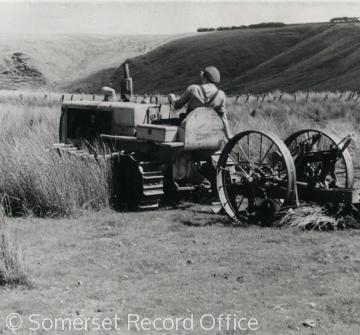Farming in the 20th century
 Subsoiling at Backpits, Exmoor, in 1952.
Subsoiling at Backpits, Exmoor, in 1952.Farming since the 1870s can be usefully divided into two major periods: 1870s to 1939, and 1947 onwards. Inevitably the war years 1914-18 and 1939-45 produced unusual conditions for farmers which do not really fit into long run trends.
From the 1870s English farming went into depression because the price of wheat fell as a result of foreign grain imports allowed in without charge because of the free trade context in which they occurred. Farmers sought protection, but it was not given by governments which were ideologically committed to free trade, and which believed that the financial future of the state lay in the promotion of industrial and commercial wealth. The result was that from the 1870s until the Second World War, the farming community was in a state of depression, eased only briefly by the impact on demand of the First World War. Farmers and their landlords reacted by turning arable land down to permanent grass. They may not have been able to compete with imports of beef, but they enjoyed advantages in terms of perishable dairy products, notably milk but also cheese. The government, made aware of the importance of food supply by the events of the First World War, and the dangers of suffering a blockade if food supply was interrupted, offered some limited protection of farmers in the 1920s, with the introduction of milk and egg marketing boards, but down to 1939 it did little more to protect the farmer. The Second World War, in which German U-boats were able to sink supply ships, led to rationing and to government recognition that the weakness of the food supply chain must never again be allowed to put the country’s security at risk. The 1947 Agriculture Act was an attempt to protect farming, but the key post-war changes were international rather than national, particularly the decision in 1961 to join the European Common Market. Once the English farmer was brought within this market from the 1960s the context in which farming operated moved to an international scale.



